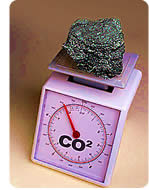 The Carbon
The Carbon
Express


 What are the facts?
What are the facts?
Does everyone agree about Carbon emissions?
 Background:
Background:
- To calculate your Carbon footprint you have to know how much energy you are using and then convert that into the equivalent weight in Carbon Dioxide using a conversion figure.
For example 1 kWh of electricity is multiplied by a conversion figure of 0.52, indicating that 0.52kg of carbon dioxide is produced when that amount of electricity is generated.
In a week an average house uses about 75 kWh of electricity. If you use a conversion figure of 0.52, its carbon footprint is 75 x 0.52 = 39kg Carbon Dioxide.
- However, what is the "correct" conversion figure? Different "carbon calculators" vary considerably in their conversion figures, giving very different results when trying to work out your carbon footprint.
Your task:
- Use the figures below to do some simple calculations to compare conversion figures for electricity production from three different sources.
- Your calculation is based on an average house using 3880 kWh electricity per year.
- To calculate, multiply this figure with the conversion factor.
Carbon Dioxide conversion figures for mains (grid) electricity:
Electricity type | Source | Conversion factor kg CO2 | CO2 kg year (based on 3880 kWh per year use) |
|---|
Grid Electricity | DEFRA/NEF | 0.43 | ? |
Grid Electricity from gas | CDIAC (USA) | 0.56 | ? |
Grid Electricity from coal | CDIAC (USA) | 0.97 | ? |
DEFRA is the Department for Environment, Food and Rural Affairs for the UK.
CDIAC is the Carbon Dioxide Information Analysis Center. USA Dept. of Energy
Discussion points:
- What is the % difference between the highest and lowest estimate?
- Do you think that these differences are significant?
- Discuss your ideas on why they might be so different with a classmate

 Now travel on to the next station: MY EMISSIONS where you will find your data for your own personal emissions.
Now travel on to the next station: MY EMISSIONS where you will find your data for your own personal emissions.
